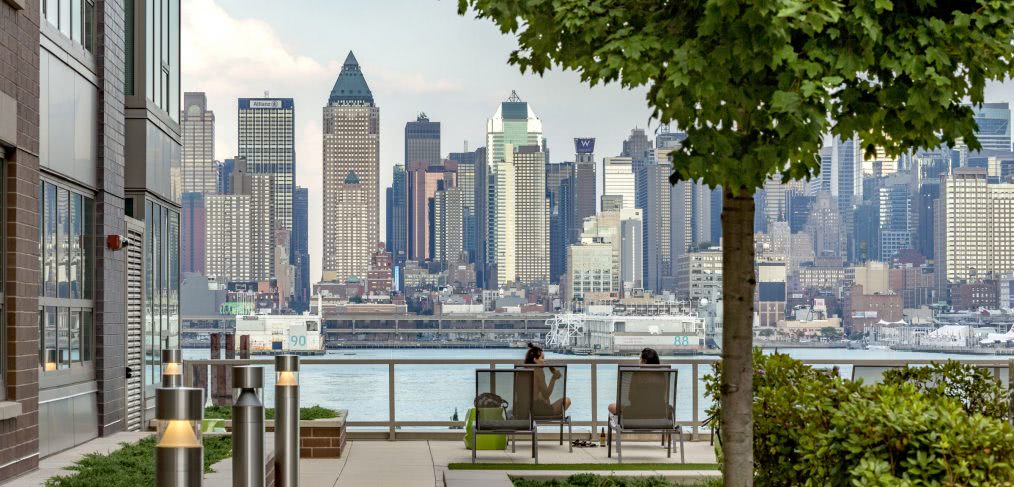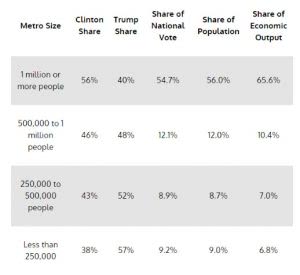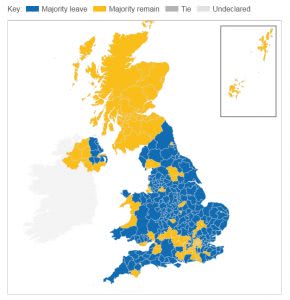
How regional planning can bring us together

On average, the more urbanized areas voted for Hillary. Source: Dave Leip’s 2016 Presidential General Election Results
CRTKL’s Maren Striker reflects on 2016.
The 2016 news cycle was dominated by Brexit and the U.S. elections. Farage and Trump came out as ultimate ‘winners,’ leaving behind a population that is completely divided about the results and what the future could look like. Growing concerns among citizens and misunderstandings between urban and rural residents—certainly in the U.S. and to a lesser extent in the UK—has led to tensions and ripples of discontent across both nations.
Richard Florida reinforces the growing divide between the U.S.’ ‘larger, denser, more affluent, more highly educated, more knowledge-based and more diverse metro areas; and its smaller, less advantaged, less educated, and less diverse metro areas.’ A more detailed look is fascinating; indicators such as income and wages, number of start-ups, race and diversity show minor differences. However, one indicator tells the story very clearly: size and density of cities. In cities of a population of over 1 million, Clinton clearly wins, while anything below that number, Trump is gaining ground—as much as 57% in cities of less than 250,000 inhabitants—as shown in the table.
It really makes we wonder. As urban planners, do we ‘care’ enough about the countryside? Planning is inherently political, so do we play a role in shaping cities that do not belong in the top 10 most populous places in a nation? Or do we only focus on the vibrant areas and follow the money? It is going to be interesting to see how this plays out for Mr. President-Elect. Heavy investments in ‘turning inner cities around’ will indeed create jobs, however the business case, which should be appealing to Mr. Trump, is supposedly better in higher density areas than in sprawled out cities where investments in public infrastructure are most needed.

London, Liverpool, Manchester, Newcastle and Leeds and Scotland clearly voted Remain. Source: BBC
In the UK, the cities vs. countryside link is not as clear, although certainly still visible—London and Scotland against the rest. Also, the heavily populated northern cities including Liverpool, Manchester, Newcastle, and Leeds voted to remain. The Brexit vote was also on average a vote from young vs. old(er). Younger people voted Remain while older people voted Leave, thus swinging the vote away from the people who will experience Brexit most keenly and for the longest; this may be for better or for worse, only time can tell. It makes me wonder though, with a growing senior population (not only in the UK but across most of the Western world), don’t we have a moral obligation to listen to the needs, wishes and dreams of the younger generation?
We know that urbanization requires more togetherness—the ability to be able to accommodate a range of communities and political views while living in close(r) physical proximity. Rural contexts have an arguably stronger sense of community, though not manifested with physical closeness. Is there a way to inspire each other? Can we build on initiatives that are already emerging to be more local in cities; think about locally grown vegetables on rooftops in cities. Can we assist low-density counties to keep facilities alive, encourage social interaction or make change something to look forward to instead of to be afraid of?
In this ‘era of cities,’ in which the world population is expected to reach 66% urbanization-rate in 2050 (from 54% in 2016), is urbanization (the only) inevitable outcome of successfully creating jobs and growing an economy or can a new model emerge? Is there a way to embrace diversity, whereby the greater good is better than the sum of its parts? Elections in Germany, France and the Netherlands are expected to see a continuation of the populist trend. I believe that by strong regional and inter-regional planning, anticipating on trends, being able to maintain facilities where they are desired, and to create jobs where needed, while respecting cities as economic powerhouses, we can start to live together again.
